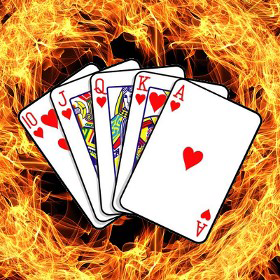ohhell
 Bid on how many tricks you'll win. But someone will inevitably miss their target...
Bid on how many tricks you'll win. But someone will inevitably miss their target...
Oh Hell! is a trick taking standard deck playing card game. The object is for each player to bid the number of tricks they think they can take from each hand, then to take exactly that many; no more and no fewer. Points are awarded only for making the bid exactly, and are deducted for missing the bid, either over or under.
The hook is that at least one player will fail on each hand, because the total number of tricks bid by the players may not equal the number of tricks available on that hand.
Also known as Oh Pshaw and Blackout.
LB_NUMBER_OF_PLAYERS: 3 - 7
Game duration: 24 mn
Complexity: 1 / 5
Play ohhell and 974 other games online.
No download, directly from your web browser.
With your friends and thousands of players from the whole world.
Free.

Play ohhell and 974 other games online.
No download, directly from your web browser.
With your friends and thousands of players from the whole world.
Free.

Rules summary
Players and Cards
From 3 to 7 people can play. The game is best when played with 4 to 6.
A standard 52 card deck is used. The cards in each suit rank (from high to low) A K Q J 10 9 8 7 6 5 4 3 2.
Sequence of Hands
The game consists of a series of hands. The first hand is played with 7 to 10 cards dealt to each player, depending on the number of players:
3 to 5 players, 10 cards each
6 players, 8 cards each
7 players, 7 cards each
(because of the limit of 52 cards available). Each successive hand is played with one card fewer, down to a hand of just one card each, then one card more per hand back up to the starting level.
Example: With 7 players, the hands are: 7 cards, then 6,5,4,3,2,1, then 2,3,4,5,6,7, for a total of 13 hands to the game. A game should take approximately 45 minutes.
Object of the Game
The object is for each player to bid the number of tricks he thinks he can take from each hand.
The hook is that at least one player will fail on each hand, because the total number of tricks bid by the players may not equal the number of tricks available on that hand.
Deal
The turn to deal rotates clockwise with each hand.
The cards are shuffled and the dealer deals the cards singly until everyone has the appropriate number of cards for the hand being played. The next card is turned face up and the suit of this card is the trump suit for the hand. The trump suit beats any of the other three suits played in that hand. The remaining undealt cards are placed in a face down stack with the turned trump on top of it.
Bidding
The bidding in each hand begins with the player to the left of the dealer, then continues clockwise, back around to the dealer, who bids last. Each bid is a number representing the number of tricks that player will try to take. Everyone must bid - it is not possible to pass, but you can bid zero, in which case your object is to take no tricks at all. Remember the hook: the dealer may not bid the number that would cause the total number of tricks bid to equal the number of tricks available; a hand will always be "over-bid" or "under-bid". Keep in mind when bidding that not all cards in the deck are in play in any hand.
Play
The play begins with the player to the dealer's left, who leads the first card. The lead may be any suit (including trump). Play follows clockwise. Each player must follow the suit led, if he can. If not, he may play any other card in his hand, including trump. The player who has played the highest trump card, or if no trump was played, the highest card of the suit led, wins the trick. That player then leads to the next trick. Continue until all tricks have been played and won.
Scoring
The scoring method used is to award 1 point for each trick won plus a bonus of 10 points for players who win exactly the number of tricks they bid. So for example a player who bid 2 would score 12 points for winning exactly 2 tricks, but only 1 for 1 trick and 3 for 3 tricks. This gives a player whose bid fails a slight incentive to win as many tricks as possible.
Variants
Here are the different variants implemented on BGA:
Game style:
- Long: As described above
- Long - Inverted: Instead of going 10 ... 1 ... 10 (or the equivalent according to the number of players), the hands go 1 ... 10 ... 1
- Short - Up and Down: Hands always go 6 ... 1 ... 6
- Short - Up: Hands always go 1 ... 10
- Short - Down: Hands always go 10 ... 1
Scoring style:
- Positive: As described above
- Neutral: 10 points + number of tricks for a successful bid. No points for a lost bid.
- Negative: 10 points for a successful bid. -10 points per tricks under or over on a lost bid.


